🔭🪐🌌🌘☄️
🔭🪐🌌🌘☄️

2024 June 23
The Colors of Saturn from Cassini Image Credit: NASA, ESA, JPL, ISS, Cassini Imaging Team; Processing & License: Judy Schmidt
Explanation: What creates Saturn’s colors? The featured picture of Saturn only slightly exaggerates what a human would see if hovering close to the giant ringed world. The image was taken in 2005 by the robot Cassini spacecraft that orbited Saturn from 2004 to 2017. Here Saturn’s majestic rings appear directly only as a curved line, appearing brown, in part from its infrared glow. The rings best show their complex structure in the dark shadows they create across the upper part of the planet. The northern hemisphere of Saturn can appear partly blue for the same reason that Earth’s skies can appear blue – molecules in the cloudless portions of both planet’s atmospheres are better at scattering blue light than red. When looking deep into Saturn’s clouds, however, the natural gold hue of Saturn’s clouds becomes dominant. It is not known why southern Saturn does not show the same blue hue – one hypothesis holds that clouds are higher there. It is also not known why some of Saturn’s clouds are colored gold.
∞ Source: apod.nasa.gov/apod/ap240623.html
More Posts from Monstrous-mind and Others
🍂🍁🎃📚📓





Flower of the Dead, essence of Aztec Marigold. Always loved October and November, The colors and essence of autumn.

“If man had no eternal consciousness, if, at the bottom of everything, there were merely a wild seething force producing everything, both large and trifling, in the storm of dark passions, if the bottomless void that nothing can fill underlay all things, what would life be but despair?”
- Albert Camus, quoting Kierkegaard in “Sysiphos”
Astronomy From 45,000 Feet
What is the Stratospheric Observatory for Infrared Astronomy, or SOFIA, up to?

SOFIA, the Stratospheric Observatory for Infrared Astronomy, as our flying telescope is called, is a Boeing 747SP aircraft that carries a 2.5-meter telescope to altitudes as high as 45,000 feet. Researchers use SOFIA to study the solar system and beyond using infrared light. This type of light does not reach the ground, but does reach the altitudes where SOFIA flies.

Recently, we used SOFIA to study water on Venus, hoping to learn more about how that planet lost its oceans. Our researchers used a powerful instrument on SOFIA, called a spectrograph, to detect water in its normal form and “heavy water,” which has an extra neutron. The heavy water takes longer to evaporate and builds up over time. By measuring how much heavy water is on Venus’ surface now, our team will be able to estimate how much water Venus had when the planet formed.

We are also using SOFIA to create a detailed map of the Whirlpool Galaxy by making multiple observations of the galaxy. This map will help us understand how stars form from clouds in that galaxy. In particular, it will help us to know if the spiral arms in the galaxy trigger clouds to collapse into stars, or if the arms just show up where stars have already formed.

We can also use SOFIA to study methane on Mars. The Curiosity rover has detected methane on the surface of Mars. But the total amount of methane on Mars is unknown and evidence so far indicates that its levels change significantly over time and location. We are using SOFIA to search for evidence of this gas by mapping the Red Planet with an instrument specially tuned to sniff out methane.

The plumes, illustrated in the artist’s concept above, were previously seen in images as extensions from the edge of the moon. Next our team will use SOFIA to study Jupiter’s icy moon Europa, searching for evidence of possible water plumes detected by the Hubble Space Telescope. The plumes were previously seen in images as extensions from the edge of the moon. Using SOFIA, we will search for water and determine if the plumes are eruptions of water from the surface. If the plumes are coming from the surface, they may be erupting through cracks in the ice that covers Europa’s oceans. Members of our SOFIA team recently discussed studying Europa on the NASA in Silicon Valley Podcast.

This is the view of Jupiter and its moons taken with SOFIA’s visible light guide camera that is used to position the telescope.
🐈⬛🐈🌌🌆🌕

Pixabay

Be Glad You Don’t Have to Dust in Space!
Throw open the windows and break out the feather duster, because spring is here and it’s time to do a little cleaning! Fortunately, no one has to tidy up the dust in space — because there’s a lot of it — around 100 tons rain down on Earth alone every day! And there’s even more swirling around the solar system, our Milky Way galaxy, other galaxies and the spaces in between.

By studying the contents of the dust in your house — which can include skin cells, pet fur, furniture fibers, pollen, concrete particles and more — scientists learn a lot about your environment. In the same way, scientists can learn a lot by looking at space dust. Also called cosmic dust, a fleck of space dust is usually smaller than a grain of sand and is made of rock, ice, minerals or organic compounds. Scientists can study cosmic dust to learn about how it formed and how the universe recycles material.

“We are made of star-stuff,” Carl Sagan famously said. And it’s true! When a star dies, it sheds clouds of gas in strong stellar winds or in an explosion called a supernova. As the gas cools, minerals condense. Recent observations by our SOFIA mission suggest that in the wake of a supernova shockwave, dust may form more rapidly than scientists previously thought. These clouds of gas and dust created by the deaths of stars can sprawl across light-years and form new stars — like the Horsehead Nebula pictured above. Disks of dust and gas form around new stars and produce planets, moons, asteroids and comets. Here on Earth, some of that space dust eventually became included in living organisms — like us! Billions of years from now, our Sun will die too. The gas and dust it sheds will be recycled into new stars and planets and so on and so forth, in perpetuity!

Astronomers originally thought dust was a nuisance that got in the way of seeing the objects it surrounded. Dust scatters and absorbs light from stars and emits heat as infrared light. Once we started using infrared telescopes, we began to understand just how important dust is in the universe and how beautiful it can be. The picture of the Andromeda galaxy above was taken in the infrared by our Spitzer Space Telescope and reveals detailed spirals of dust that we can’t see in an optical image.

We also see plenty of dust right here in our solar system. Saturn’s rings are made of mostly ice particles and some dust, but scientists think that dust from meteorites may be darkening the rings over time. Jupiter also has faint dusty rings, although they’re hard to see — Voyager 1 only discovered them when it saw them backlit by the Sun. Astronomers think the rings formed when meteorite impacts on Jupiter’s moons released dust into orbit. The Juno spacecraft took the above picture in 2016 from inside the rings, looking out at the bright star Betelgeuse.

Copyright Josh Calcino, used with permission
And some space dust you can see from right here on Earth! In spring or autumn, right before sunrise or after sunset, you may be able to catch a glimpse of a hazy cone of light above the horizon created when the Sun’s rays are scattered by dust in the inner solar system. You can see an example in the image above, extending from above the tree on the horizon toward a spectacular view of the Milky Way. This phenomenon is called zodiacal light — and the dust that’s reflecting the sunlight probably comes from icy comets. Those comets were created by the same dusty disk that that formed our planets and eventually you and the dust under your couch!
Make sure to follow us on Tumblr for your regular dose of space: http://nasa.tumblr.com
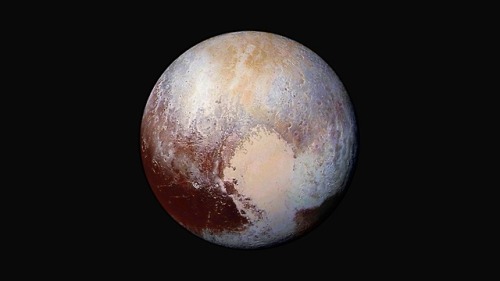

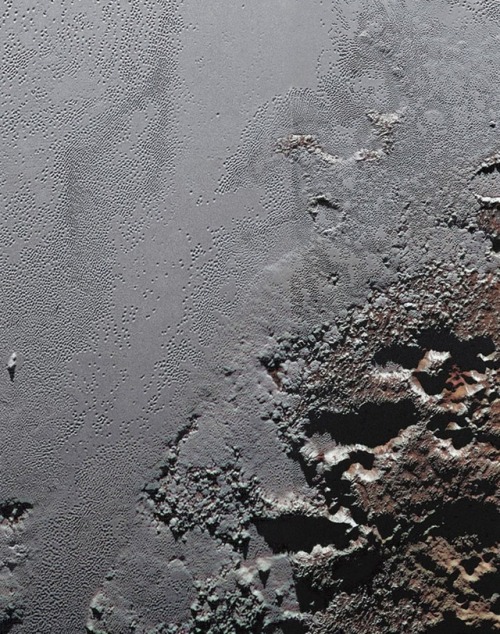
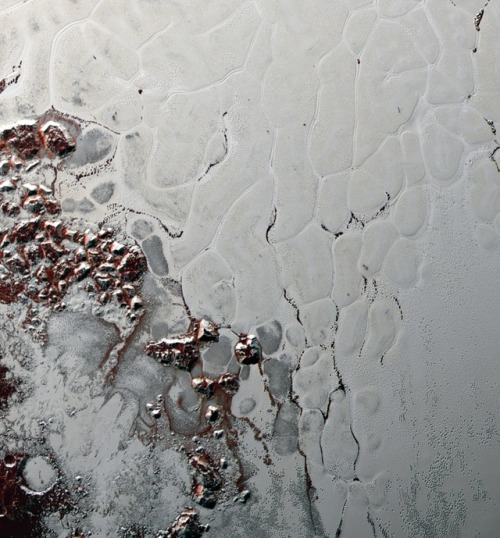
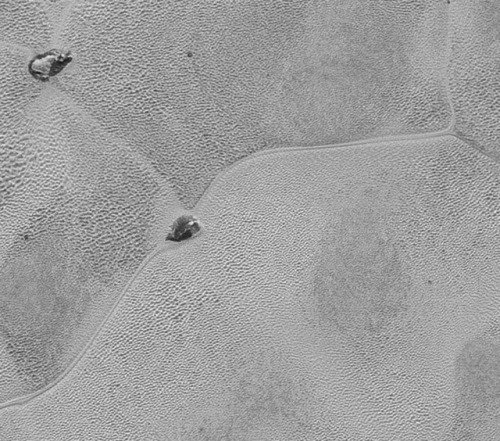
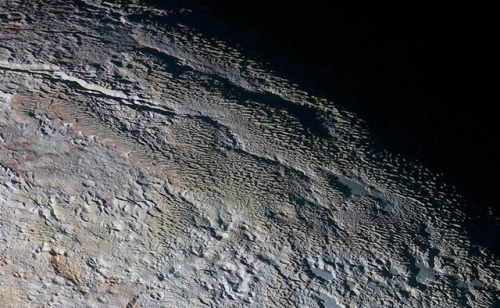
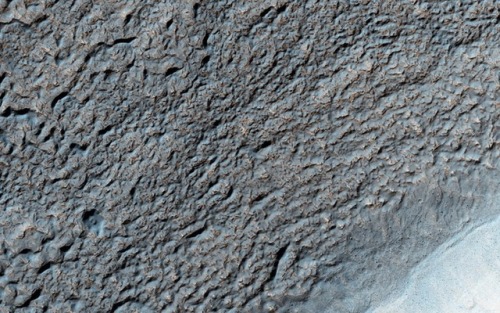
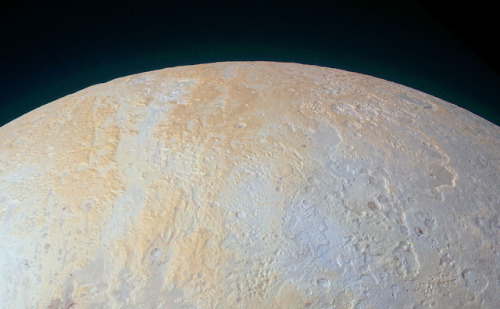
High-resolution images of Pluto taken by NASA’s New Horizons spacecraft.
The plains on Pluto’s surface are composed of more than 98 percent nitrogen ice, with traces of methane and carbon monoxide. Nitrogen and carbon monoxide are most abundant on the anti-Charon face of Pluto (around 180° longitude, where Tombaugh Regio’s western lobe, Sputnik Planitia, is located), whereas methane is most abundant near 300° east. The mountains are made of water ice. Pluto’s surface is quite varied, with large differences in both brightness and color. Pluto is one of the most contrastive bodies in the Solar System, with as much contrast as Saturn’s moon Iapetus. The color varies from charcoal black, to dark orange and white. Pluto’s color is more similar to that of Io with slightly more orange and significantly less red than Mars. Notable geographical features include Tombaugh Regio, or the “Heart” (a large bright area on the side opposite Charon), Cthulhu Macula, or the “Whale” (a large dark area on the trailing hemisphere), and the “Brass Knuckles” (a series of equatorial dark areas on the leading hemisphere). Sputnik Planitia, the western lobe of the “Heart”, is a 1,000 km-wide basin of frozen nitrogen and carbon monoxide ices, divided into polygonal cells, which are interpreted as convection cells that carry floating blocks of water ice crust and sublimation pits towards their margins; there are obvious signs of glacial flows both into and out of the basin. It has no craters that were visible to New Horizons, indicating that its surface is less than 10 million years old.
source | images: NASA/JPL
🔭🌃🌌

M44, the beehive Cluster in Cancer constellation
Credit: Alan Dyer
🔭🌃🌌


Galaxy UGC 2885 may be the largest one in the local universe. It is 2.5 times wider than our Milky Way and contains 10 times as many stars. This galaxy is 232 million light-years away, located in the northern constellation of Perseus.
Credit: NASA, ESA, and B. Holwerda (University of Louisville)
-
 wachsurfer2018 liked this · 9 months ago
wachsurfer2018 liked this · 9 months ago -
 afragmentcastadrift reblogged this · 9 months ago
afragmentcastadrift reblogged this · 9 months ago -
 dragonwrangler liked this · 9 months ago
dragonwrangler liked this · 9 months ago -
 dreaming-of-stories-and-stars liked this · 9 months ago
dreaming-of-stories-and-stars liked this · 9 months ago -
 heathen-beast reblogged this · 9 months ago
heathen-beast reblogged this · 9 months ago -
 eregyrn-falls reblogged this · 9 months ago
eregyrn-falls reblogged this · 9 months ago -
 eregyrn-falls liked this · 10 months ago
eregyrn-falls liked this · 10 months ago -
 fayefrogs reblogged this · 10 months ago
fayefrogs reblogged this · 10 months ago -
 fayefrogs liked this · 10 months ago
fayefrogs liked this · 10 months ago -
 hbgchriswonders liked this · 10 months ago
hbgchriswonders liked this · 10 months ago -
 riddlemaster101 reblogged this · 10 months ago
riddlemaster101 reblogged this · 10 months ago -
 dragonflysrevenge liked this · 10 months ago
dragonflysrevenge liked this · 10 months ago -
 shekelesh-z liked this · 10 months ago
shekelesh-z liked this · 10 months ago -
 boomstab-papa reblogged this · 10 months ago
boomstab-papa reblogged this · 10 months ago -
 astronomyforastrologers reblogged this · 10 months ago
astronomyforastrologers reblogged this · 10 months ago -
 bal0neymalon3y liked this · 10 months ago
bal0neymalon3y liked this · 10 months ago -
 bluestaratsunrise reblogged this · 10 months ago
bluestaratsunrise reblogged this · 10 months ago -
 bluestaratsunrise liked this · 10 months ago
bluestaratsunrise liked this · 10 months ago -
 ismiles-posts liked this · 10 months ago
ismiles-posts liked this · 10 months ago -
 cats-cats-and-more-vocaloid liked this · 10 months ago
cats-cats-and-more-vocaloid liked this · 10 months ago -
 synonyms-for-cinnamon reblogged this · 10 months ago
synonyms-for-cinnamon reblogged this · 10 months ago -
 searaeberry reblogged this · 10 months ago
searaeberry reblogged this · 10 months ago -
 searaeberry liked this · 10 months ago
searaeberry liked this · 10 months ago -
 dravanianwyvern liked this · 10 months ago
dravanianwyvern liked this · 10 months ago -
 leonorthoughts liked this · 10 months ago
leonorthoughts liked this · 10 months ago -
 metalhead-maglor liked this · 10 months ago
metalhead-maglor liked this · 10 months ago -
 wigmund reblogged this · 10 months ago
wigmund reblogged this · 10 months ago -
 ztxtz reblogged this · 10 months ago
ztxtz reblogged this · 10 months ago -
 webweasel liked this · 10 months ago
webweasel liked this · 10 months ago -
 gregorlenko liked this · 10 months ago
gregorlenko liked this · 10 months ago -
 wigmund liked this · 10 months ago
wigmund liked this · 10 months ago -
 astrodances liked this · 10 months ago
astrodances liked this · 10 months ago -
 lefoujd liked this · 10 months ago
lefoujd liked this · 10 months ago -
 futuristicallymysticcollective liked this · 10 months ago
futuristicallymysticcollective liked this · 10 months ago -
 dabb444 reblogged this · 10 months ago
dabb444 reblogged this · 10 months ago -
 dabb444 liked this · 10 months ago
dabb444 liked this · 10 months ago -
 meteorologistaustenlonek reblogged this · 10 months ago
meteorologistaustenlonek reblogged this · 10 months ago -
 meteorologistaustenlonek liked this · 10 months ago
meteorologistaustenlonek liked this · 10 months ago -
 monstrous-mind reblogged this · 10 months ago
monstrous-mind reblogged this · 10 months ago -
 monstrous-mind liked this · 10 months ago
monstrous-mind liked this · 10 months ago -
 nessieac liked this · 10 months ago
nessieac liked this · 10 months ago -
 justanoldfashiontumblog liked this · 10 months ago
justanoldfashiontumblog liked this · 10 months ago -
 riddlemaster101 liked this · 10 months ago
riddlemaster101 liked this · 10 months ago -
 spacefaringcat liked this · 10 months ago
spacefaringcat liked this · 10 months ago -
 arcanetrivia liked this · 10 months ago
arcanetrivia liked this · 10 months ago -
 silvereyedowl liked this · 10 months ago
silvereyedowl liked this · 10 months ago -
 stellarskyes liked this · 10 months ago
stellarskyes liked this · 10 months ago
My ambition is handicapped by laziness. -C. Bukowski Me gustan las personas desesperadas con mentes rotas y destinos rotos. Están llenos de sorpresas y explosiones. -C. Bukowski. I love cats. Born in the early 80's, raised in the 90's. I like Nature, Autumn, books, landscapes, cold days, cloudy Windy days, space, Science, Paleontology, Biology, Astronomy, History, Social Sciences, Drawing, spending the night watching at the stars, Rick & Morty. I'm a lazy ass.
222 posts